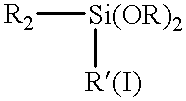Composition for promoting adhesion between rubber and textiles
a technology of textiles and rubber, applied in the field of composition for promoting adhesion between textiles and rubber, can solve the problems of textiles not adhesion effective to rubber, separation of two layers, and mechanical failure of the resulting composi
- Summary
- Abstract
- Description
- Claims
- Application Information
AI Technical Summary
Benefits of technology
Problems solved by technology
Method used
Image
Examples
example 1
7 parts of aminoethylaminopropyltrimethoxy silane and 3 parts of 3-methacryloxypropyltrimethoxysilane were admixed in a beaker. To this mixture was slowly added a total amount of 1000 parts water in order to obtain a stable dispersion of silanes. Subsequently, the resultant dispersion was then transferred to a receptacle suitable for dipping fabric substrates. A 100% polyester sample of smooth filament fabric, cut into a few swatches of 2 inches by 12 inches and each swatch was then consecutively dipped into the dispersion, run through two compressing rolls to squeeze out excess liquid, and then dried at 177.degree. C. for 3 minutes in an oven. The fabric was then impregnated with a regular resorcinol formaldehyde vinylpyridine latex (formula provided by a technical bulletin released by Indspec of Pittsburgh, Pennsylvania, October, 1991). A formulated and uncured SBR rubber was then sandwiched between the two treated textile layers. The whole structure was then pressed at four tons / ...
example 2
The same procedure was followed as in EXAMPLE 1 except that the mixture of amine-functional silane and methacrylic silane was replaced by 2-(vinylbenzylamino)-ethyl-3-aminopropyltrimethoxysilane. A peel strength of 30 lbs / inch was obtained.
PUM
| Property | Measurement | Unit |
|---|---|---|
| temperature | aaaaa | aaaaa |
| hydrophobic | aaaaa | aaaaa |
| adhesion | aaaaa | aaaaa |
Abstract
Description
Claims
Application Information
 Login to View More
Login to View More - R&D
- Intellectual Property
- Life Sciences
- Materials
- Tech Scout
- Unparalleled Data Quality
- Higher Quality Content
- 60% Fewer Hallucinations
Browse by: Latest US Patents, China's latest patents, Technical Efficacy Thesaurus, Application Domain, Technology Topic, Popular Technical Reports.
© 2025 PatSnap. All rights reserved.Legal|Privacy policy|Modern Slavery Act Transparency Statement|Sitemap|About US| Contact US: help@patsnap.com



